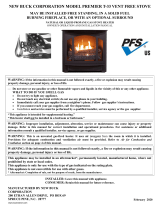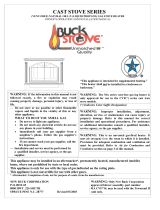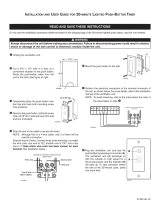
Page 1
6. During initial operation, slight
smoking could occur due to
heater burning manufacturing
residues.
7. To prevent creation of soot, follow
instructions in “Cleaning and
Maintenance”, page 19.
8. Before using furniture polish,
wax, carpet cleaners or similar
products, turn heater off. If heated,
vapors from these products may
create a white powder residue
within burner box or on adjacent
walls or furniture.
9. This heater has an Oxygen
Depletion Sensing (ODS) safety
shutoff system. The ODS shuts
down heater if not enough fresh
air is available. See “Air for
Combustion and Ventilation”,
pages 3 through 5. If heater keeps
shutting off, see “Trouble-
shooting”, pages 20 through 22.
10. Do not run heater
where flammable liquids or vapors
are used or stored
under dusty conditions
11. Do not use this stove to cook food
or burn paper or other objects.
12. Do not use heater if any part has
been exposed to or under water.
Immediately call a qualified
service technician to inspect room
heater and to replace any part of
control system and any gas control
which has been under water.
13. Do not operate heater if any log is
broken.
14. Turn heater off and let cool before
servicing. Only a qualified service
person should service and repair
heater.
15. Operating heater above elevations
of 4,500 feet could cause pilot
outage.
16. Do not place stove directly on
carpeting, vinyl tile or any
combustible material other than
wood. The stove must set on a
metal or wood panel extending the
full width and depth of the
appliance.
WARNINGS:
IMPORTANT: Read this
owner’s manual carefully and
completely before trying to
assemble, operate or service this
heater. Improper use of this
heater can cause serious injury or
death from burns, fire, explosion,
electrical shock and carbon
monoxide poisoning.
DANGER: Carbon monoxide
poisoning may lead to death!
NOTE: When burning any unit
or appliance that combusts fuel
for heat, such as coal, oil, wood
or natural and (L.P.) liquid
petroleum gas. We highly
recommend the use of smoke
and carbon monoxide detectors
in your home.
Carbon Monoxide Poisoning:
Early signs of carbon monoxide
poisoning resemble the flu, with
headaches, dizziness or nausea. If
you have these signs, heater may
not be working properly. Get
fresh air at once! Have heater
serviced. Some people are more
affected by carbon monoxide than
others. These include pregnant
women, people with heart or lung
disease or anemia, those under
influence of alcohol and those at
high altitudes.
Make certain you read and
understand all Warnings. Keep
this manual for reference. It is
your guide to safe and proper
operation of this heater.
WARNING: Any change to this
heater or its controls can be
dangerous.
WARNING: Do not allow fans
to blow directly into the stove.
Avoid any drafts that alter
burner flame patterns. Ceiling
fans can create drafts that alter
burner flame patterns. Altered
burner patterns can cause
sooting.
WARNING: Do not use a
blower insert, heat exchanger
insert or other accessory not
approved for use with this
heater.
VENT FREE STOVE SERIES SAFETY INFORMATION
Due to high temperatures the
appliance should be located out of
traffic and away from furniture and
draperies.
Do not place clothing or other
flammable material on or near
appliance. Never place any objects on
heater.
Stove becomes very hot when running
heater. Keep children and adults away
from hot surfaces to avoid burns or
clothing ignition. Stove will remain
hot for a time after shutdown. Allow
surfaces to cool before touching.
Carefully supervise young children
when they are in the room with
heater. When using handheld remote
accessory, keep selector switch in
OFF position to prevent children from
turning on burners with remote.
Keep appliance area clear and free
from combustible materials, gasoline
and other flammable vapors and
liquids.
1. This appliance is only for use
with the type of gas indicated on
rating plate. This appliance is not
convertible for use with other
gases.
2. If you smell gas
shut off gas supply
do not try to light any appliance
do not touch any electrical
switch: do not use any phone in
your building
immediately call your gas
supplier from a neighbor’s phone.
Follow gas supplier’s instructions
if you cannot reach your gas
supplier, call fire department
3. This heater shall not be installed
in a bedroom or bathroom.
4. Do not use this stove as a wood
burning fireplace. Use only
models:
series
vent-free gas log heater.
3. Do not add extra logs or
ornaments such as pine cones,
vermiculite or rock wool. Using
these added items can cause
sooting.
CVFB200(LP),
CVFB200(NAT),
C100BA(LP) or
C100BA(NAT)























